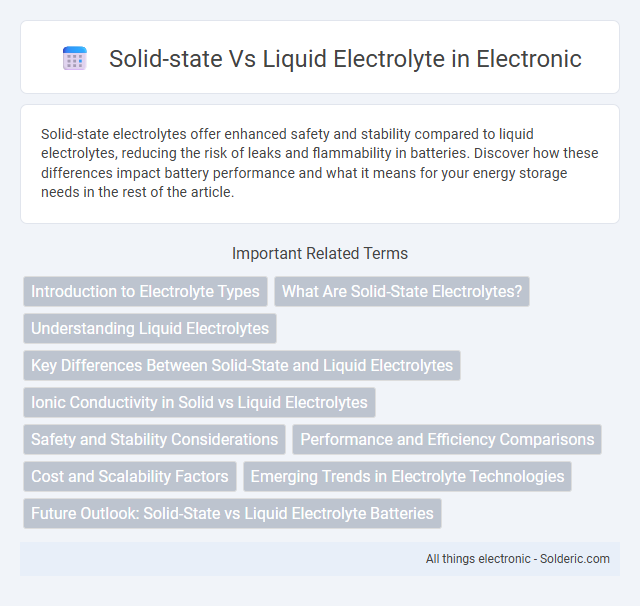Solid-state electrolytes offer enhanced safety and stability compared to liquid electrolytes, reducing the risk of leaks and flammability in batteries. Discover how these differences impact battery performance and what it means for your energy storage needs in the rest of the article.
Comparison Table
| Feature | Solid-State Electrolyte | Liquid Electrolyte |
|---|---|---|
| Composition | Solid ionic conductors (ceramics, polymers) | Liquid electrolytes (organic solvents with dissolved salts) |
| Safety | Higher safety, non-flammable, reduced leakage risk | Flammable, risk of leakage and thermal runaway |
| Energy Density | Potential for higher energy density due to stable interface | Moderate energy density, limited by electrolyte stability |
| Operating Temperature | Wide temperature range, stable at higher temperatures | Limited temperature range, vulnerable at extremes |
| Cycle Life | Longer cycle life, less capacity fade | Shorter cycle life, capacity degrades faster |
| Manufacturing Complexity | Complex fabrication, higher production cost | Established, cost-effective manufacturing processes |
| Ion Conductivity | Lower ionic conductivity at room temperature | High ionic conductivity at room temperature |
| Applications | Next-gen batteries, electric vehicles, grid storage | Consumer electronics, electric vehicles, portable devices |
Introduction to Electrolyte Types
Solid-state electrolytes, composed of rigid materials such as ceramics or polymers, offer enhanced safety and stability by eliminating flammable liquid components. Liquid electrolytes, typically based on organic solvents with dissolved salts like lithium hexafluorophosphate (LiPF6), provide high ionic conductivity and facilitate efficient ion transport in lithium-ion batteries. The choice between solid-state and liquid electrolytes significantly impacts battery performance, energy density, and thermal management in advanced energy storage systems.
What Are Solid-State Electrolytes?
Solid-state electrolytes are materials that conduct ions without the presence of a liquid phase, offering enhanced safety and stability compared to traditional liquid electrolytes used in batteries. These electrolytes typically consist of ceramic, glass, or polymer-based substances that enable efficient ion transport while preventing leakage and flammability risks. For your energy storage needs, solid-state electrolytes can provide higher energy density, longer lifespan, and improved thermal performance.
Understanding Liquid Electrolytes
Liquid electrolytes are crucial components in conventional lithium-ion batteries, primarily composed of organic solvents mixed with lithium salts to facilitate ion transport between electrodes. Their high ionic conductivity and ease of manufacturing contribute to widespread commercial use, but challenges like leakage, flammability, and limited electrochemical stability hinder safety and longevity. Research continues to optimize liquid electrolyte formulations to improve battery performance while mitigating risks associated with thermal runaway and electrolyte decomposition.
Key Differences Between Solid-State and Liquid Electrolytes
Solid-state electrolytes offer enhanced safety and stability by eliminating flammable liquids and reducing leakage risks compared to liquid electrolytes commonly used in batteries. They provide higher ionic conductivity at elevated temperatures and improved electrochemical compatibility with electrodes, resulting in longer battery life and better performance. Your choice between solid-state and liquid electrolytes impacts device efficiency, energy density, and thermal management in applications such as electric vehicles and portable electronics.
Ionic Conductivity in Solid vs Liquid Electrolytes
Ionic conductivity in liquid electrolytes typically surpasses that of solid-state electrolytes due to the higher mobility of ions in liquid phases, facilitating faster charge transfer. Solid-state electrolytes offer enhanced safety and stability but often face challenges with lower ionic conductivity and grain boundary resistance. Optimizing your battery performance involves balancing these conductivity differences to achieve both efficiency and durability.
Safety and Stability Considerations
Solid-state electrolytes offer enhanced safety by eliminating flammable liquid components, significantly reducing the risk of leakage and combustion compared to conventional liquid electrolytes. Their solid nature provides superior thermal and electrochemical stability, resulting in longer battery life and better performance under extreme conditions. You can rely on solid-state technology for safer, more stable energy storage in applications like electric vehicles and portable electronics.
Performance and Efficiency Comparisons
Solid-state electrolytes offer higher ionic conductivity and enhanced thermal stability compared to liquid electrolytes, resulting in improved battery performance and safety. They enable greater energy density and longer cycle life, reducing efficiency losses associated with leakage and evaporation common in liquid electrolytes. Your devices benefit from more consistent power output and faster charging capabilities when utilizing solid-state technology over conventional liquid electrolyte systems.
Cost and Scalability Factors
Solid-state electrolytes typically have higher production costs due to complex manufacturing processes and the need for specialized materials, which currently limits large-scale commercialization. Liquid electrolytes benefit from lower costs and well-established supply chains, enabling easier scalability for mass production of batteries. Advances in solid-state technology aim to reduce expenses and improve scalability by enhancing material compatibility and manufacturing techniques.
Emerging Trends in Electrolyte Technologies
Solid-state electrolytes are gaining momentum due to their enhanced safety, thermal stability, and potential for higher energy density compared to traditional liquid electrolytes. Innovations in ceramic, polymer, and composite solid electrolytes aim to overcome challenges like interfacial resistance and mechanical brittleness. Concurrently, liquid electrolytes are evolving with novel additives and high-concentration formulations that improve ionic conductivity and electrochemical stability, driving next-generation lithium-ion and beyond battery technologies.
Future Outlook: Solid-State vs Liquid Electrolyte Batteries
Solid-state batteries offer enhanced safety, higher energy density, and longer lifespan compared to traditional liquid electrolyte batteries, making them promising candidates for next-generation energy storage. Liquid electrolyte batteries currently dominate the market due to their established manufacturing processes and lower costs, but advancements in solid-state technology are rapidly closing this gap. Your choice between these battery types will increasingly depend on specific application requirements, such as energy density, safety needs, and long-term sustainability goals.
Solid-state vs Liquid electrolyte Infographic

 solderic.com
solderic.com